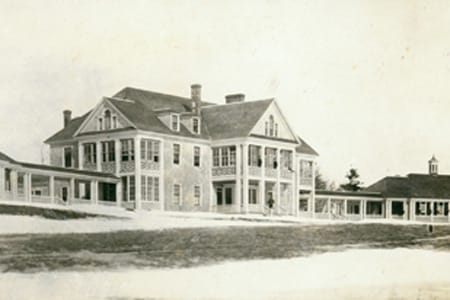The TB facility came and went, its disappearance a symbol of PEI pride and self reliance.
To the First World War-era residents of rural and rolling Emyvale, PEI, the sprawling Dalton Sanatorium must have seemed like an apparition, rising out of red soil through the Island mist in 1916. The facility's namesake, Sir Charles Dalton-a millionaire businessman, politician and the Island's Lieutenant-Governor from 1930 until his death in 1933-paid more than $50,000 to build the tuberculosis facility; construction took nearly three years, and before long the sanatorium was expanded from a 24 to 100 bed facility to accommodate soldiers.
But for all the work that went into the buildings they would disappear a mere few years later, in 1923, board by board, window by window and bed by bed, until practically all that remained was the handsome Victorian-style doctors' home. Along with the buildings, the TB patients also disappeared, either purified by Island sun and air or returned home to another form of annexation, in family houses - or felled by the so - called White Death.

Prince Edward Island has an unusual TB history. At the peak of the epidemic the province had Canada's highest TB death rate, losing an average of 100 people per year. It was thought of as the "cancer" of its time. And some stigmas, it seems, never go away. As recently as 1982, when Island historian Boyde Beck was accepted at Queens University in Kingston, Ont, he was subjected to a strange kind of initiation: he was the only person in his class required to provide proof that he was free of the disease.
Experts from Nova Scotia and the United States had chosen the Emyvale site-on the Clarkin Road, 20 kilometres west of Charlottetown - for its open, rural quality, its elevation, its exposure to the sun, its proximity to both Charlottetown and the North Wiltshire train stations and its isolation, although resident patients were apparently not above roaming about and visiting homes in the area for card games and a nip or two whenever they grew tired of the monotony.
The sanatorium was for "insipient" patients only, those in the early stages of the disease; people in the advanced stages of TB were apparently excluded. The main building included a common area and two single-storey wings of individual rooms that initially housed up to 24 patients.
The government agreed to operate the facility in association with the Dalton Sanatorium Commission, a five-member board that included medical staff, people from the TB association and of course, Dalton himself. The complex was completely self-contained, including a working farm, an ice house, water tower, laundry facilities, kitchens, medical facilities, the still-existing doctor's house, a small vocational school to help occupy and train residents and a coal-fired power plant. The power plant lit the entire complex-a rural oddity the likes and lights of which could be seen for miles all around. Electricity, after all, did not reach this and many other areas of rural PEI until the early 1960s.
Semi-retired Island history teacher and University of Prince Edward Island lecturer Leonard Cusack was born 61 years ago not far from the Clarkin Road. His combined love of history and connection to the community have compelled him to chase down the intricacies of the Dalton Sanatorium story and write a book on the subject. For Cusack, the compulsion to do the book is all the more riveting because the story is a microcosm of "Island-ness."
"In essence, it represents Island society," he says, referring to the traits of independence, pride and self-sufficiency. "It shows how Islanders thought, rightly or wrongly, right up to the top."
Dalton knew these characteristics all too well when he persuaded the Island government, of which he was a sitting member, to finance the operation of a sanatorium if he agreed to build it. Even with this attractive offer, the decision to operate such a health facility was a huge leap for the Conservatives under then-Premier John A. Mathieson. Even more then than now constituents had a powerful aversion to paying taxes of any sort, pointedly illustrated by the fact that no department of health existed in those days. With the exception of the Falconwood Insane Hospital in Charlottetown, hospitals were run by special-interest groups, such as the Catholic Church. According to popular opinion less government was considered the best government. If people were sick, they were tended to at home. Compounding the anti-taxation attitude was the fact that TB was seen as a taint against those who had it, associated with unkempt domestic conditions.
Dalton's philanthropic motivation to establish the sanatorium was most certainly because he lost two daughters to TB. Plus, despite being born poor in Norway, PEI, he had no trouble affording it, having raised a fortune in western PEI, honestly but as craftily as a fox. Between 1895 and 1910, he and a tightly knit consortium formed a monopoly known as the Big Six - they owned the entire silver fox farming industry. Dalton and the others shared a gentlemen's agreement to sell pelts but no live pups, an agreement that held until a relative of one of the six encountered financial troubles and sold a pair of pups outside the circle. But during that 15-year heyday, Dalton and the others were garnering $1,000 per pelt, turning them into millionaires.
In 1917, with the building's interior paint hardly dry, the federal government arrived on the scene in the form of the Military Hospitals Commission and negotiated with the province to assume ownership of the centre. They decreed that the facility was needed for the war effort - TB was reputed to be a rampant problem for soldiers in the First World War - and set about to expand the premises from a single to a two-storey structure. When renovations were complete in 1919, at an additional cost of $300,000 to $400,000, the building had the capacity of housing 100 patients. All the trouble and expense they'd gone to aside, the feds then no longer needed the sanatorium because the war had ended.
The centre was handed over to a less-than-enthusiastic Liberal government that had assumed power and had criticized its construction from the beginning. With virtually no outcry ensuing, the province shut the doors and de-commissioned the property; the place was gone in no time. After all Sir Charles Dalton's hard work and investment in establishing the hospital he must have been perplexed, if not angry. It would be nearly a decade before Islanders would again have the benefit of a sanatorium or hospital, which was finally erected in Charlottetown.
Today the former doctors' residence is a private home to a Paul and Kim McDonald and family. Paul's father, Leonard, lives on the site, too, his annexed circular-shaped home built to conform to the shape of a highly unusual roof: the massive steel base of the sanatorium water tower flipped upside down.
With Leonard Cusack's experience in hunting down history - he is an appointed member of the Historic Sites and Monuments Board of Canada-he knows it's the stories behind the story that will most intrigue the readers of his forthcoming book. With the political players of the day long gone, he should have a free hand in telling the story unencumbered, just as it unfolded. The apparition of Emyvale will again take shape, this time in permanent literary form that can't be deconstructed.
